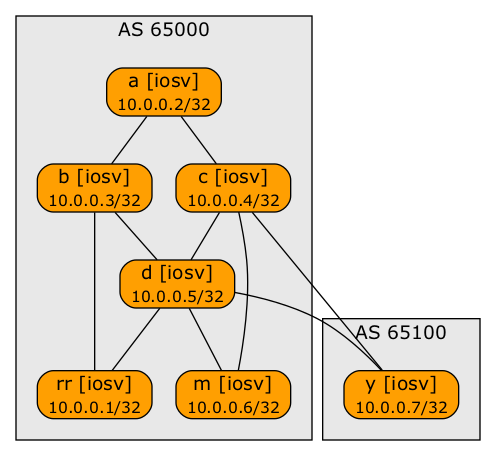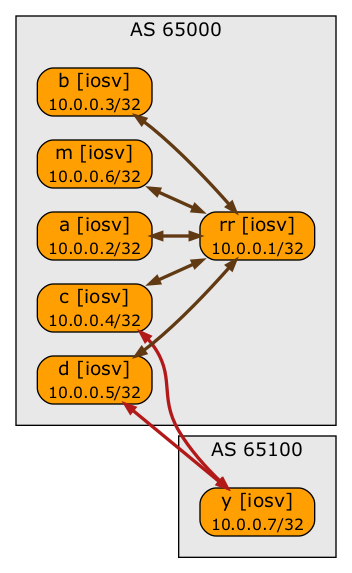Optimal BGP Path Selection with BGP Additional Paths
A month ago I explained how using a BGP route reflector in a large-enough non-symmetrical network could result in suboptimal routing (or loss of path diversity or multipathing). I also promised to explain how Advertisement of Multiple Paths in BGP functionality1 solves that problem. Here we go…
I extended the original lab with another router to get a scenario where one route reflector (RR) client should use equal-cost paths to an external destination while another RR client should select a best path that is different from what the route reflector would select.
The following diagrams show the “physical” lab topology and the BGP sessions:

Physical Lab Topology

BGP Sessions
In the ideal world:
- Route Reflector (RR) would select RR-D-Y as the best path toward 10.42.42.0/24 (the prefix advertised by Y)
- A would select A-C-Y as the best path toward the same prefix
- M would use ECMP between M-C-Y and M-D-Y paths.
To get there, the route reflector has to advertise D-Y and C-Y paths to A and M, but the rules of BGP (RFC 4271) prevent that. If RR advertises two paths to the same prefix, the second update overwrites the first one because they describe the same prefix. Back to the drawing board.
Technology
RFC 7911 extends the advertised prefix (Network Layer Reachability Information – NLRI) with a Path Identifier to solve the multiple updates of the same prefix conundrum. Obviously one cannot just send the new data structures to an unsuspecting BGP neighbor; BGP neighbors must negotiate the new functionality with BGP capabilities exchange, usually bringing down the BGP session as an interesting side effect.
RFC 7911 allows a BGP speaker to advertise that it’s willing to send multiple paths, receive multiple paths or both. For a working solution, one of the neighbors must be willing to receive multiple paths, and the other one must be will to send them. Obviously it’s also possible to have a two-way exchange.
Selecting the paths that are advertised to a neighbor willing to receive multiple paths is a local implementation decision. Implementations of BGP Additional Paths functionality have further nerd knobs that allow you to specify:
- Which alternate paths should be considered to be interesting;
- Which interesting alternate paths should be advertised to individual neighbors.
Any gotchas? Sure. The path identifier is a local variable and might not be preserved across Graceful Restarts. In the words of RFC 7911:
As the Path Identifiers are locally assigned, and may or may not be persistent across a control plane restart of a BGP speaker, an implementation SHOULD take special care so that the underlying forwarding plane of a “Receiving Speaker” as described in RFC4724 is not affected during the graceful restart of a BGP session.
I read that as fun times, bugs ahead; you might be more optimistic.
Design
In small IBGP network, the route reflector(s) should send additional paths to the RR clients to enable multipathing or optimal path selection. There is no need for the clients to send multiple paths to the route reflector assuming the clients change the next hop on IBGP updates. The proof is left as an exercise for the reader.
In a larger network using multiple RR levels, you probably need a two-way exchange of multiple paths between route reflectors.
Our network is not highly redundant (there are few alternate paths to every external prefix), so it’s perfectly fine to send all additional paths to every RR client. You might want to reduce the number of additional paths sent to edge routers in larger networks – it’s always a tradeoff between memory/CPU utilization and path selection optimality.
Lab Time
Of course I tried to wing it… and failed. RTFM helped; here’s how to make BGP additional paths work on Cisco IOS:
- The additional paths functionality is configured within an address family.
- On the route reflector, I enabled it globally with the bgp additional-paths send address family configuration command… and lost all BGP sessions in a jiffy. You might want to schedule a maintenance window in a production network.
- On the RR clients I enabled the willingness to receive multiple paths with neighbor additional-paths receive configuration command… and lost the BGP session to the route reflector (but at least I wasn’t surprised anymore).
And nothing happened. Configuring BGP sessions is not good enough, you have to specify which additional paths you want to consider with the bgp additional-paths select command. I decided to use all additional paths, and in a few seconds I could see a change in the BGP table on the route reflector (notice the all keyword next to the suboptimal path)
rr(config-router-af)#bgp additional-paths select all
rr(config-router-af)#do show ip bgp 10.42.42.0
BGP routing table entry for 10.42.42.0/24, version 14
Paths: (2 available, best #2, table default)
Path not advertised to any peer
Refresh Epoch 1
65100, (Received from a RR-client)
10.0.0.4 (metric 3) from 10.0.0.4 (10.0.0.4)
Origin IGP, metric 0, localpref 100, valid, internal, all
rx pathid: 0, tx pathid: 0x1
Path advertised to update-groups:
2 3
Refresh Epoch 1
65100, (Received from a RR-client)
10.0.0.5 (metric 2) from 10.0.0.5 (10.0.0.5)
Origin IGP, metric 0, localpref 100, valid, internal, best
rx pathid: 0, tx pathid: 0x0
Still, I could see no change on the RR client. There’s another trick: you have to configure the willingness to send additional paths for every neighbor with neighbor advertise additional-paths configuration command. Interestingly, you could decide to select all alternate paths in the BGP table, but advertise only some of them to a neighbor2
rr(config-router-af)#neighbor 10.0.0.6 advertise additional-paths all
After that change (which did not bring down the IBGP session), the RR client got multiple paths to the same prefix from the route reflector:
m#show ip bgp 10.42.42.0
BGP routing table entry for 10.42.42.0/24, version 25
Paths: (2 available, best #1, table default)
Not advertised to any peer
Refresh Epoch 1
65100
10.0.0.4 (metric 2) from 10.0.0.1 (10.0.0.1)
Origin IGP, metric 0, localpref 100, valid, internal, best
Originator: 10.0.0.4, Cluster list: 10.0.0.1
rx pathid: 0x1, tx pathid: 0x0
Refresh Epoch 1
65100
10.0.0.5 (metric 2) from 10.0.0.1 (10.0.0.1)
Origin IGP, metric 0, localpref 100, valid, internal
Originator: 10.0.0.5, Cluster list: 10.0.0.1
rx pathid: 0x0, tx pathid: 0
Final step: enable BGP multipath on the RR client with maximum-paths address family configuration command… and finally we can see C and D as the next hops in the IP routing table. Mission accomplished ;))
Routing entry for 10.42.42.0/24
Known via "bgp 65000", distance 200, metric 0
Tag 65100, type internal
Last update from 10.0.0.5 00:00:05 ago
Routing Descriptor Blocks:
10.0.0.5, from 10.0.0.1, 00:00:05 ago
Route metric is 0, traffic share count is 1
AS Hops 1
Route tag 65100
MPLS label: none
* 10.0.0.4, from 10.0.0.1, 00:00:05 ago
Route metric is 0, traffic share count is 1
AS Hops 1
Route tag 65100
MPLS label: none
Creating Configuration Templates
I plan to do further tests along the same lines, so I decided to convert the manual process into a configuration template:
router bgp {{ bgp.as }}
address-family ipv4 unicast
{% if bgp.rr is defined %}
bgp additional-paths select all
bgp additional-paths send
{% else %}
maximum-paths 16
maximum-paths ibgp 16
{% endif %}
{% for n in bgp.neighbors if n.type == 'ibgp' %}
{% if bgp.rr is defined %}
neighbor {{ n.ipv4 }} advertise additional-paths all
{% else %}
neighbor {{ n.ipv4 }} additional-paths receive
{% endif %}
{% endfor %}
Finally, I added the template as a custom deployment template to the topology file. Now I can get a fully-configured lab with a simple netlab up command.
module: [ bgp, ospf ]
defaults.device: iosv
bgp.as: 65000
groups:
net:
members: [ a,b,c,d,m,rr ]
config: [ bgp-addpath.j2 ]
ext:
members: [ y ]
config: [ test-loopback.j2 ]
...
Want do to your own tests? Install netlab, build your own virtual lab environment, and use this set of configuration files.
Want to learn more? Explore BGP-related blog posts and How Networks Really Work webinar.

It would be great to continue with your considerations about BGP add-path vs Internet in VRF.
We'll do that in a Design Clinic. Internet-in-a-VRF is already on the list of topics.
Hi Ivan, for a setup I designed at work, I‘d like to know, if a route reflector can have multiple path for a route (default route in our network) and decide, which of them to advertise to a group of neighbors? Thanks!
As always, it depends... this time on what the BGP implementation in your route reflector can do. Vendor documentation would be the place to check ;)
Obviously I have no idea what you're trying to do, and maybe Optimum Route Reflection (ORR) would be exactly what you need. If not, you could always try to filter outgoing BGP updates with a route map (or equivalent) -- get all the paths into the RR RIB, tell RR to advertise all of them to all clients, and then filter the updates (assuming it works -- see above).
However, based on the complexity of what we're discussing, I strongly suspect it might be a good idea to go back to the drawing board and adapt the design.